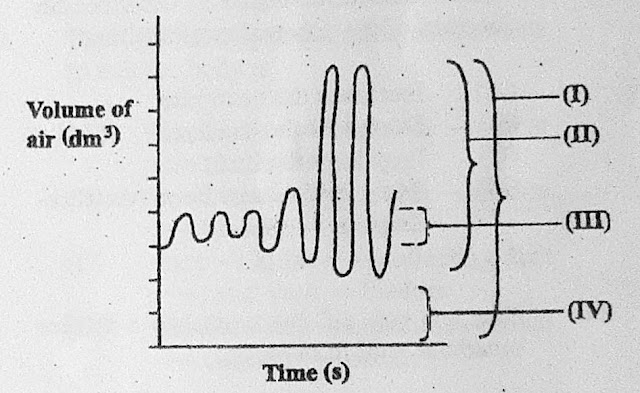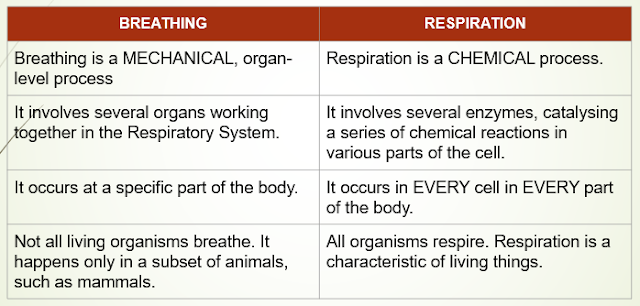BREATHING RATE & FACTORS THAT INFLUENCE IT [HSB]
- [B2.4] outline the factors affecting the rate of breathing;
- [B2.5] explain the concept of vital capacity;
The average resting breathing rate for an adult human is 14 breaths per minute.
This is just enough to supply the oxygen needed to fuel the normal activities of the body's cells.
However, resting rate does not use the entire capacity of the lungs. This lung capacity is expressed in terms of inhalation and exhalation.
The total volume of air that your lungs can hold after taking the biggest possible breath in is known as you total lung capacity. The average is 6,000 cm³. It changes with body size and fitness.
In fact, it has been shown that regular aerobic exercise
increases a person's lung volume.
Vital capacity can also be expressed as follows:
VC = TV + IRV + ERV
IRV --> Inspiratory Reserve Volume: the total extra air that you can breathe in.
ERV --> Expiratory Reserve Volume: the total extra air that you can breathe out.
FACTORS THAT AFFECT BREATHING RATE
When breathing rate changes, the depth of breathing also increases.
Breathing rate = number of breaths/minute
Depth of breathing = volume of air taken in per breath
They are both also affected by many factors.
The following generally causes an INCREASE
Anything that increases the oxygen requirements of the body will tend to increase the breathing rate. That includes the following:
- Exercise, anxiety, excitement, moving to a high altitude such as Mexico City & La Paz
- Increase in weight, smoking, sitting in a poorly ventilated ('stuffy') space with no fresh air
- Taking stimulant drugs such as amphetamines.
The following generally causes a DECREASE
- Recovering from exercise, sleep, returning to a lower altitude, moving from a poorly ventilated space to fresh air.
- Taking depressant drugs such as barbiturates.
The MAIN Internal Influence, however,
is the concentration of carbon dioxide in the blood.
The brain detects changes in this variable and then determines how often and how deeply you breathe in order to keep carbon dioxide concentration constant in the body.
This is a homeostatic mechanism.
The medulla in the brain automatically controls our rate of breathing. Extra carbon dioxide in the blood - such as during exercise - stimulates faster, deeper breathing.
Deeper, faster breathing not only removes carbon dioxide. It also leads to the taking in of more oxygen.
EXERCISE
Regular exercise is very beneficial for respiratory health.
When we begin to exercise, our muscles start contracting harder and faster. As a result, they need more glucose and oxygen to supply their energy needs.
During exercise, the muscles also produce increased amounts of carbon dioxide, which needs to be removed so they can keep working efficiently.
Therefore, during exercise, the breathing rate increases & we breathe more deeply. In this way, more oxygen is brought into the body and more carbon dioxide can be removed from the blood and breathed out.
Long-term effects of exercise include:
- Decreased resting breathing rate
- Increased:
- volume of air breathed per minute
- vital capacity
- tidal volume
- number of functioning alveoli
- strength of intercostal muscles & diaphragm
Fit people breathe more slowly because - with exercise - their lungs get bigger and intercostal muscles get stronger.
ANXIETY
The body has a natural response to fear.
Your body reacts to a frightening experience by releasing the hormone adrenaline. This hormone can stimulate various responses, including increase in breathing rate.
This, in turn, increases the rate of cellular respiration. The extra energy that is released can be used in 'fight-or-flight' response to danger.
'Fight' isn't always actual combat. Sometimes it is short-lived but remarkable strength, such as freeing someone trapped under a heavy object.
Anxiety is an inappropriate fear response.
The body behaves like it is under a fight-or-flight situation in the absence of a real external threat / danger.
Anxiety can lead to:
- shortness of breath, leading to a faster breathing rate
- a tight feeling in the chest, even to the point of feeling suffocated.
Another helpful strategy is exercise, which channels surplus energy released by the anxiety response.
DRUGS
Some drugs lower breathing rate, while others increase it.
- Sedatives, such as sleeping pills, narcotic pain relief, and heroin depress the activity of the breathing centre of the brain.
- High alcohol levels have the same effect as sedatives.
- High levels of depressant drugs can lead to such a low respiratory rate that it is lethal. for example, a person with acute alcohol poisoning requires hospital treatment to support their breathing.
- Stimulants, such as caffeine, nicotine, amphetamines, and cocaine increase breathing rate.
Smoking & Vaping
Ciliated epithelial cells and mucus-secreting cells are some of the first to be negatively affected by cigarette smoking or vaping.
Thicker mucus is produced in greater quantities, but the cilia movements slow down. Therefore the mucus is not being swept up to the throat fast enough. The person therefore resorts to frequently coughing to remove the mucus, which makes them breathless.
Long-term smokers and vapers suffer further damage to the lungs, which makes breathing difficult.
ENVIRONMENTAL FACTORS
- High levels of carbon dioxide stimulates the breathing regulatory centre to increase the breathing rate.
This also gets more air, with oxygen, into the lungs. - If you are in very hot surroundings, one's metabolic rate slows down to reduce the production of heat.
As a result, cellular respiration, and breathing rate, slows. - Allergic reactions to environmental stimuli, such as pollen and smoke, can inflame the bronchi and bronchioles.
This makes these passageways into the lungs narrower, reducing the volume air that can move through them per breath.
The breathing rate therefore increases, to compensate for the smaller volume.
ALTITUDE
As a result, your respiratory system must work harder to supply oxygen to your bloodstream. Your breathing rate thus increases.
Altitude Sickness
People who live at sea level need to acclimate to the high altitude. Otherwise, such persons would develop altitude sickness.
This can set in at heights of approximately 2,500 metres. From this point, climbers would start to feel the effects of lack of oxygen.
This condition can be lethal.
Signs & Symptoms
Includes lack of energy & feeling dizzy. More serious symptoms include fluid in the lungs.
Treatment
For mild altitude sickness, the person should rest to see if they adjust. If they don't, they should move to lower altitudes.
For severe altitude sickness, the person should descend to a lower altitude IMMEDIATELY, using as little energy as possible. Ideally, they should be carried down.
Adaptations for Living at High Altitudes
People who live at high altitudes are adapted to the lower air pressure and lower oxygen level.
They include:
- more red blood cells
- larger hearts
- larger lungs and chest cavities
OBESITY & BEING OVERWEIGHT
Over half of the population of the Caribbean is overweight, and about 23% are obese.
Shallow breathing is common in people with obesity, and this makes exercise more difficult for them.
Lack of exercise further weakens the intercostal muscles and diaphragm, meaning that obesity and low activity combine to make the problem worse.
People who are overweight or obese often have shortness of breath, because excess fat in and around the chest cavity make breathing movements difficult.
The excess body f
at in the abdomen causes the diaphragm to be pushed up, restricting its movement and making it hard to breathe.





